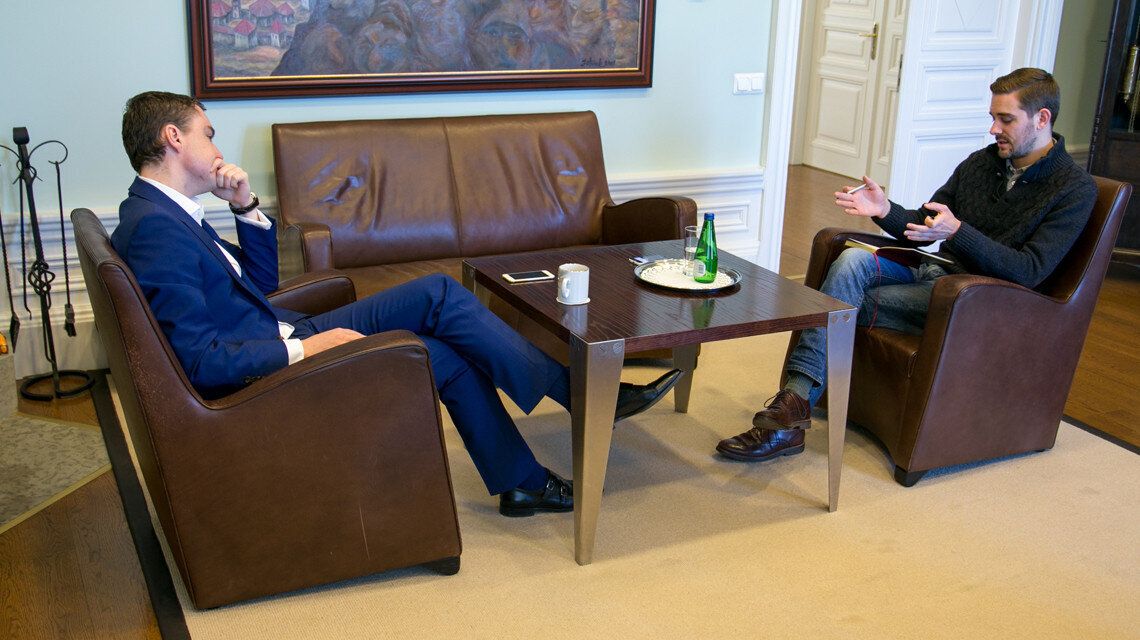Beyond The Ballot is The Huffington Post UK's alternative take on the General Election, taking on the issues too awkward for Westminster. It focuses on the unanswered questions around internet freedom, mental health and housing.

"Today it takes you a maximum of five clicks."
Estonia's Prime Minister Taavi Rõivas is not a boastful person, however it's hard not to feel a pang of jealousy when anyone says the phrase, 'it takes you a maximum of five clicks' in relation to doing your taxes.
The 35-year old politician might have the weight of being one of the EU's youngest leaders on his shoulders but if there's one thing he doesn't have to worry about, it's his taxes.
"People used to stand in lines 15 years ago just to fill in all the documents asking how much I’d made, where I made it, what’s the code of registration of my company where I work - it's outrageous.
This system now takes me two minutes if I’m really slow, and people like it, people like using this service."
The reason that Rõivas -- and every Estonian -- can fill out their taxes so quickly is simple: their identity is digital, along with almost every other major government service.
"A political decision was made 15 years ago to give every Estonian a digital identity," explains the Prime Minister. "So if everyone has this digital ID, and you know that 100 per cent it’s as valid by law as your physical signature, then you have this infrastructure that you can build on, with any service."
Once agreed, the next step was the small matter of issuing a digital identity to over a million people. At the turn of the century this process was far more complex than it would have been today.
"I would be lying if I said it went without any difficulties, I think at first people were somewhat hesitant to use these ID cards.
We didn't have the Mobile ID [we have today], we needed special hardware, so the smart card readers. Of course computers 15 years ago didn’t have smart card readers so we had to distribute them physically, we had to teach people how to use them, how to install drivers - it was a little bit difficult for some."
For Estonians, the way to prove your identity has advanced substantially over the years. The country started with large physical smart cards that would have the unique biometric identifiers saved onto a chip. Of course, as technology advanced, so too did the system, resulting in the creation of the Mobile ID. By using a special SIM card, Estonians can now prove their identity using their smartphones.
How does it work? When they request to sign into a service (driving authority, internet banking) using Mobile ID the smartphone is sent a unique four-digit pin code. The user enters that into the login form and the website loads. The easiest way to describe it working in real-life is that it's similar to the two-stage authentication for Gmail or Facebook, except that of course the SIM card is encrypted and approved by the Police.
"I wouldn’t say that Estonians are particularly tech savvy, we are [simply] a pragmatic people who actually think that doing things this way saves us time, saves us money, makes life easier, and why bother dealing with huge piles of paper?"
This paperless view is one that Rõivas rigorously puts into practise every single day: before we sat down to talk the young Prime Minister invited me to watch him approve three laws using just his iPhone 6.

Estonian Prime Minister Taavi Rõivas approves three Bills using Mobile ID on his iPhone 6
Paper isn't the only thing that the Estonian government is now able to cut down on. "It’s much better for government to have things running digitally because you need less people," he says.
"For example with the register of social securities, we are now building a new information system which allows us to do the same things with far fewer people, around 20 per cent less civil servants."
As each government service became digitally focused, it became clear that there were additional benefits as well.
"What this gives us is the added possibility of interconnectivity [between government departments], so say for example my home is not on that street but on the other one and this is my new address, you can give permission to the tax authority and they’ll know immediately that you’ve moved address, without [you] having to go present your gas bill etc."
This interconnectivity has resulted in some massive financial savings. The introduction of the digital identity alone saves the country two per cent of its annual GDP, and that's before you take into account the streamlining of each individual government service.
Two per cent of GDP is incidentally a very important figure for Estonia, considering its location on the border with Russia. It's the NATO target for each member state's defence budget, something that until now only Estonia, the UK and the US have fulfilled. As Rõivas rather poetically points out, "the digital signature pays for our defence."
If this all seems too good to be true then the reality is that it is, because for Estonia, the metaphorical naughty child in the room is i-voting.
Having been in place for 10 years, the system is digital democracy at the bleeding edge. Estonians can use their Mobile ID/Smart Card to vote online, a step that hasn't been without controversy.
In May 2014 the Guardian ran a piece which cited a team of independent experts who claimed to have found major security flaws in Estonia's voting system.

10 October, 2005: former Estonian Prime Minister Andrus Ansip casts his first online vote
The experts had taken Estonia's voting software and built their very own version, rigorously testing it. They said what they found "alarmed" them.
It's fair to say that what followed was a back-and-forth between Estonia's Electronic Voting Committee and the research team, with each refuting various claims.
The final result was simply that neither could agree. Estonia's voting committee insisted that because the test was carried out in laboratory conditions with hidden security measures, it wasn't accurate. Whereas the researchers claimed that this wouldn't have made a difference to the results.
Regardless, i-voting remains in use in Estonia to this day and while it's being constantly updated, the country insists it hasn't once found any evidence of hacking or tampering. While other countries watch on, the small country had to persuade its own citizens in the first place that i-voting was the most secure, and the most convenient way of voting.
For a country that has been free of the Soviet Union for just 26 years, the initial concerns about i-voting in Estonia were perhaps different to those we would feel in the UK.
"When we started the main issue was whether there would be someone who could force you to vote because of course you’d be voting in the privacy of your home or in your office, so nobody would be able to see if you were being forced or not."
Rõivas explains that to combat this they came up with a simple solution, you can re-vote as many times as you want. Only the last vote is counted. Other measures have since been put in place to help voters understand that while they might not be in a polling station, they're still in control.
"We’ve built this functionality where you’re sent a QR code which allows you to check if your vote went to the central system."
It's not just e-voting that's getting attention: the entire digital infrastructure is reportedly constantly analysed and evaluated, with some quite drastic measures being considered.
"We have been discussing the possibilities of having the physical data centres in our country backed up into the cloud through many other countries, perhaps in Britain... so that we have physical independence of this single location."
While the idea of an entire country being backed up to the cloud might sound scary, for Estonia it is simply the next logical step. Following the devastating hacking attack that almost brought Estonia's banking services to its knees in 2007, the advantages are clear: if a country's physical infrastructure were damaged or knocked out all together, wouldn't it be better to have a backup system, a 'virtual government' that still made sure people were paid, and that the country could carry on running?
So what does all this mean for the UK? Could the United Kingdom make the transition towards a digital government? Despite previous concerns about the cost of introducing a digital identity, the trend seems to be that the UK -- whether it likes it or not -- will be dragged in a similar direction to Estonia.
At the turn of the year the UK's Digital Democracy Commission announced some tough targets for a parliament that, until recently, was paper-first.
Among them was the recommendation that by 2020, every citizen in the United Kingdom should be able to vote online.
Drastic changes to parliament have also been suggested, including the adoption of the smart identity cards that some MPs already own. It would finally allow MPs to still vote in the division lobbies even if they weren't able to attend (through illness or personal circumstances).
While it's clear that comparing our two countries is impossible (Estonia's population is smaller than Manchester), the fact remains that Rõivas's people made a long-term decision which has, by-in-large, resulted in them being one of the states most digitally-prepared for the coming years.

